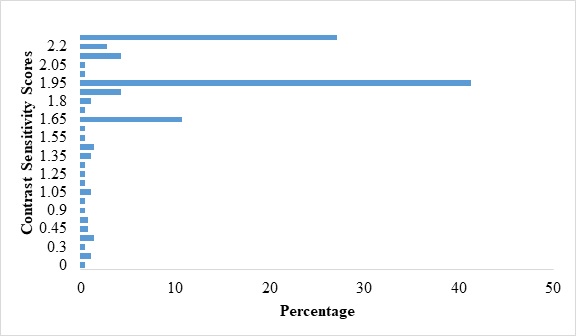Risk Factors and Prevalence of Contrast Sensitivity Impairment among Commercial Motor Vehicle Drivers in Benin City, Nigeria
Abstract
 Abstract Views: 0
Abstract Views: 0
Background. Contrast sensitivity (CS) is the innate ability of the eyes to discern any variation in luminance or brightness between an object and its background within a given space. CS is important for recognizing lane markers, road signs, and oncoming traffic while driving, especially in low contrast environments, such as at night or during foggy weather. This survey aimed to evaluate the risk factors and prevalence of CS impairment among drivers of commercial motor vehicles in Benin City, Edo State, Nigeria.
Methods. This study employed an observational cross-sectional survey of 341 drivers of commercial motor vehicles aged 20-70 years (with the mean age of 48.09 years ± 11.21 years) in Benin City. The sample comprised 326 (96.6%) male drivers and 15 (4.4%) female drivers. The sample was selected using the purposive random sampling technique. The data was collected through the adjusted National Eye Institute Visual Functioning Questionnaire-25. Pelli-Robson test was performed to assess contrast sensitivity. Data was analysed using IBM-SPSS (version 29.0). Chi-square test was used to observe significant differences between CS and the associated risk factors.
Results. The prevalence of impaired CS in this study was 21.7%. It increased with the increase in age from 7.9% among the age group 20-30 years to 48.0% among the age group > 60 years. Higher educational level was found to correlate with decreased CS impairment.
Conclusion. The high prevalence of CS in this study could be a threat to safe driving, especially in low contrast environments, if appropriate measures are not put in place to identify drivers with CS impairment. Routine CS assessment of drivers is recommended preceding the issuance of driver’s license and relicensing.
Downloads
References
Peden M, Scurfield R, Sleet D, et al. World report on road traffic injury prevention. World Health Organization; 2004.
Fanai S, Mohammadnezhad M. The perception of public transport drivers (PTDs) on preventing road traffic injury (RTIs) in Vanuatu: a qualitative study. Int J Qual Studies Health Well-being. 2022;17(1):e2047253. https://doi.org/10.1080/17482631.2022.2047253
Ahmed M, Patnaik JL, Whitestone N, et al. Visual impairment and risk of self-reported road traffic crashes among bus drivers in Bangladesh. Asia-Pacific J Ophthalmol. 2022;11(1):72–78. https://doi.org/10.1097/APO.0000000000000471
Findings revealed that a self-reported history of a motor vehicle crash was connected with near or distance visual impairment.
Kumari N, Anand A. Retinitis pigmentosa-recent advances in treatment. EyeQuest. 2020;45(1):73–78.
Mashige KP, van Staden DB. Prevalence of congenital colour vision deficiency among Black school children in Durban, South Africa. BMC Res Notes. 2019;12(1):e324. https://doi.org/10.1186/s13104-019-4374-1
Dairo MD, Okechukwu-Nwankpa UP, Nwankpa R. Survey on visual acuity among intra-city commercial vehicle drivers in Ibadan, southwestern Nigeria. J Public Health Afr. 2019;10(1):e789. https://doi.org/10.4081/jphia.2019.789
Bener A, Ahmad M, El-Tawil M, Al Bakr S. Visual impairment and motor vehicle accidents. Middle East J Emerg Med. 2004;4(1):39–43.
Adewole AO, Olufemi A, Saheed G. Health care seeking behaviour for visual dysfunction among motor vehicle drivers in Osun State, Southwest Nigeria. Pan Afr Med J. 2019;32(1):1–9.
Kumar M, Mahaseth A, Parveen S, Rafeeq U, Chauhan L. Refractive errors among commercial drivers. Indian J Ophthalmol. 2022;70(6):2112-2116. https://doi.org/10.4103/2222-8888.358922
Ovenseri-Ogomo G, Adofo M. Poor vision, refractive errors and barriers to treatment among commercial vehicle drivers in the Cape Coast municipality. Afr Health Sci. 2011;11(1):97–102. https://doi.org/10.4314/ahs.v11i1.65003
Alvarez-Peregrina C, Martinez-Perez C, Villa-Collar C, Sánchez-Tena MÁ. Influence of vision on drivers: a pilot study. Int J Environ Res Public Health. 2021;18(22):e12116. https://www. mdpi.com/1660-4601/18/22/12116
Kwon JM, Lee SJ. Factors affecting contrast sensitivity in intermittent exotropia. Korean J Ophthalmol. 2020;34(5):392–397. https://doi.org/10.3341/kjo.2020.0058
Wang S, Sharma A, Dawson J, Rizzo M, Merickel J. Visual and cognitive impairments differentially affect speed limit compliance in older drivers. J Am Geriatr Soc. 2021;69(5):1300–1308. https://doi.org/10.1111/jgs.17008
Wood JM. Nighttime driving: visual, lighting and visibility challenges. Ophthalmic Physiol Opt. 2020;40(2):187–201. https://doi.org/ 10.1111/opo.12659
Jones PR, Ungewiss J, Eichinger P, Wörner M, Crabb DP, Schiefer U. Contrast sensitivity and night driving in older people: quantifying the relationship between visual acuity, contrast sensitivity, and hazard detection distance in a night-time driving simulator. Front Hum Neurosci. 2022;16:e914459. https://doi.org/10.3389/fnhum.2022.914459
CS in this research was evaluated in a driving simulator with the use of Landolt CS, featured under a static or a dynamic driving situation, in the presence or absence of glare. Resulted revealed that the connection between CS and performance during driving was distinct. Furthermore, CS was seen to be reduced in the presence of glare.
Kimlin JA, Black AA, Djaja N, Wood JM. Development and validation of a vision and night driving questionnaire. Ophthalmic Physiol Opt. 2016;36(4):465–476. https://doi.org/10.1111/opo.12307
Owens DA, Wood JM, Owens JM. Effects of age and illumination on night driving: a road test. Hum Factors. 2007;49(6):1115–1131. https://doi.org/10.1518/001872007X249974
Owsley C, McGwin G. Vision and driving. Vision Res. 2010;50(23):2348–2361. https://doi.org/10.1016/j.visres.2010.05.021
Gruber N, Mosimann U, Müri R, Nef T. Vision and night driving abilities of elderly drivers. Traffic Injury Prev. 2013;14:477–485. https://doi.org/10.1080/15389588.2012.727510
Ghasemi M, Hosein S, Yazdi H. Comparison of visual status of iranian military and commercial drivers. Iran Red Crescent Med J. 2015;17(4):e19751. https://doi.org/10. 5812/ircmj.17(4)2015.19751
Here, visual function was compared between 200 drivers each of Iranian military and commercial trucks. It was shown that age was a significant risk factor to CS impairment.
van Rijn L, Nischler C, Michael R, Heine C, Coeckelbergh T, Wilhelm H. Prevalence of impairment of visual function in European drivers. Acta Ophthalmol. 2011;89(2):124–131. https://doi.org/10.1111/j.17553768.2009.01640.x
Chung S, Legge G. Comparing the shape of contrast sensitivity functions for normal and low vision. Invest Ophthalmol Visual Sci. 2016;57:198–207. https://doi.org/10.1167/iovs.15-18084
Pang Y, Allen M, Robinson J, Frantz K. Contrast sensitivity of amblyopic eyes in children with myopic anisometropia. Clin Exp Optom. 2019;102:57–62. https://doi.org/10.1111/cxo.12817
Haliza A, Muziman Syah M, Norliza M. Visual problems of new Malaysian drivers. Malays Family Phys. 2010;5(2):95–98.
Wood J, Owens D. Standard measures of visual acuity do not predict drivers’ recognition performance under day or night conditions. Optom Vis Sci. 2005;82:698–705. https://doi.org/10. 1097/01.opx.0000175562.27101.51
Hashemi H, Khabazkhoob M, Jafarzadehpur E, Emamian M, Shariati M, Fotouhi A. Contrast sensitivity evaluation in a population-based study in Shahroud, Iran. Ophthalmology. 2012;119(3):541–546. https://doi.org/10.1016/j.ophtha.2011.08.030
Wood J. Age and visual impairment decrease driving performance as measured on a closed-road circuit. Hum Fact. 2002;44(3):482–494. https://doi.org/10.1518/0018720024497664
Johnson C, Wilkinson M. Vision and driving: the United States. J Neuroophthalmol. 2010;30(2):170–176. https://doi.org/10.1097/WNO. 0b013e3181df30d4
Oladehinde M, Adeoye A, Adegbehingbe B, Al E. Visual functions of commercial drivers in relation to road accidents in Nigeria. Indian J Occup Environ Med. 2007;11:71–75. https://doi.org/10. 4103/0019-5278.34532
National Population Commission. Population Distribution by Sex, State, LGA & Senatorial district. 2006. http://www.population.gov.ng/index.php/publication/140-popn-distri-by-sex-state-jgas-and-senatorial-distr-2006
Onaiwu DN. Rural-Urban integration and spatial planning in Edo State, Nigeria. Ghana J Geograph. 2021;13(1):50-62. https://doi.org/10. 4314/gjg.v13i1.3
Cochran WG. Sampling Techniques. John Wiley and Sons; 1963.
Azuamah Y, Obeme-Ndukwe O, Esenwah E, et al. An assessment of the visual acuity and contrast sensitivity of commercial vehicle drivers in Rivers State, Nigeria. Int J Res. 2014;1(9):1269–1275.
National Eye Institute. Visual functioning questionnaire - 25 (VFQ-25). 2000. https://www.nei.nih.gov/ learn-about-eye-health/outreach-resources/outreach-materials/visual-function-questionnaire-25
Moyegbone JE, Nwose E, Kio F, et al. Prevalence and pattern of visual impairment among adult population in mangu local government area of Plateau State, Nigeria. Ophthalmol Res: Int J. 2023;18(2):18–29. https://doi.org/10.9734/or/2023/v18i2381
World Health Organization. World report on vision: vision, eye conditions and vision impairment. World Health Organization; 2019.
Flaxman SR, Bourne R, Resnikoff S, et al. Global causes of blindness and distance vision impairment 1990–2020: a systematic review and meta-analysis. Lancet Global Health. 2017;5(12):e1221–e1234. https://doi.org/10.1016/S2214-109X(17)30393-5
Moyegbone J, Nwose E, Anowa E, Clarke A, Odoko J, Agege A. Prevalence of visual impairment among primary and secondary school children in Delta State, Nigeria. J Nigerian Optom Assoc. 2023;25(1):42–53. https://dx.doi.org /10.4314/jnoa.v25i1.7
Almaliotis D, Almpanidou S, Chatzimbalis T. Correlation between color vision, visual acuity, contrast sensitivity and photostress recovery in the visually impaired: a cross-sectional study. Ann Med Surg. 2024;86:742–747. https://doi.org/10.1097/MS9. 0000000000001522
Pelli DG, Robson JG, Wilkins AJ. The design of a new letter chart for measuring contrast sensitivity. Clinic Vision Sci. 1988;2(3):187–199.
Kingsnorth A, Drew T, Grewal B, et al. Mobile app Aston contrast sensitivity test. Clinic Experiment Optom. 2016;99:350. https://doi.org/10.1111/ cxo.12362
Elliott D. Clinical Procedures in Primary Eye Care. Elsevier; 2007.
Kobal N, Hawlina M. Comparison of visual requirements and regulations for obtaining a driving license in different European countries and some open questions on their adequacy. Front Hum Neurosci. 2022;16:e927712. https://doi.org/10.3389/fnhum.2022.927712
Owsley C, Stalvey B, Wells J, Sloane M, McGwin G. Visual risk factors for crash involvement in older drivers with cataract. Arch Ophthalmol. 2001;119:881–887. https://doi.org/10.1001/archopht.119.6.881
Marottoli RA, Richardson ED, Stowe JR, Miller E, Brass LM, Cooney LM. Development of a test battery to identify older drivers at risk for self-reported adverse driving events. J Am Geriatr Soc. 1998;46(5):562–568. https://doi.org/10.1111/j.1532-5415.1998.tb01071.x
Adler N, Stewart J. Health disparities across the lifespan: meaning, methods, and mechanisms. Ann New York Acad Sci. 2010;1186(1):5–23. https://doi.org/10.1111/j.1749-6632.2009.05337.x
Zhang X, Bullard KM, Cotch MF, et al. Association between depression and functional vision loss in persons 20 years of age or older in the United States, NHANES 2005–2008. JAMA Ophthalmol. 2014;132(10):1193–1200. https://doi.org/10.1001/ jamaophthalmol.2014.1337
Ekpenyong B, Echendu D, Ekanem E. Visual health status and its relationship with road traffic accidents amongst Nigerian vehicle drivers. African Vision Eye Health. 2020;79(1):1–8.
Researchers investigated the status of functional vision among Nigerian drivers and their relationship with road traffic clashes using 3521 drivers recruited from 27 States and the Federal Capital Territory. They discovered that the proportion of drivers who underwent vision tests prior to issuance of a driver's license was very low, and drivers with impaired vision were two times more likely to be involved in a road traffic collision compared with those with healthy eyes.
Odugbo OP, Wade PD, Velle LD, Kyari F. Prevalence of presbyopia, refractive errors and use of spectacles among commercial intercity vehicle drivers in Jos, Nigeria. J Med. 2012;6(1):37–41. https://doi.org/10. 4314/jjm.v6i1
Pepple G, Adio A. Visual function of drivers and its relationship to road traffic accidents in Urban Africa. SpringerPlus. 2014;3:e47. https:// doi.org/10.1186/2193-1801-3-47
Rubin GS, Ng ES, Bandeen-Roche K, Keyl P, Freeman E, West SK. A prospective, population-based study of the role of visual impairment in motor vehicle crashes among older drivers: the SEE Study. Invest Ophthalmol Visual Sci. 2007;48:1483–1491. https://doi.org/10.1167/iovs.06-0474
Cross J, McGwin G, Rubin G, et al. Visual and medical risk factors for motor vehicle collision involvement among older drivers. Br J Ophthalmol. 2009;93(3):400–404. https://doi.org/10.1136/bjo.2008.144584
Wood J, Anstey KJ, Kerr G, Lacherez P, Lord S. A multidomain approach for predicting older driver safety under in-traffic road conditions. J Am Geriatr Soc. 2009;57(5):936–944. https://doi.org/10.1111/j.15325415.2009.02241.x
Ortiz-Peregrina S, Ortiz C, Casares-López M, Castro-Torres JJ, Del Barco LJ, Anera RG. impact of age-related vision changes on driving. Int J Environ Res Public Health. 2020;17(20):e7416. https://doi.org/10.3390/ijerph17207416
Twenty-one younger drivers (aged 25–40) were assessed for visual acuity, contrast sensitivity, halos, and intraocular straylight and compared to 21 older drivers (aged 56–71). Their results demostrate that older participants had reduced CS, and were most affected by straylights.
Owsley C. Aging and vision. Vision Res. 2011;51(13):1610–1622. https:// doi.org/10.1016/j.visres.2010.10.020

Copyright (c) 2025 John Esimaje Moyegbone, Eghonghon Ehianata Oronsaye, Aghafekokhian Bose Osaiyuwu, Patricia Tonbra Osunu, Jennifer Aleye Ebeigbe, Ezekiel Uba Nwose

This work is licensed under a Creative Commons Attribution 4.0 International License.
BSR follows an open-access publishing policy and full text of all published articles is available free, immediately upon publication of an issue. The journal’s contents are published and distributed under the terms of the Creative Commons Attribution 4.0 International (CC-BY 4.0) license. Thus, the work submitted to the journal implies that it is original, unpublished work of the authors (neither published previously nor accepted/under consideration for publication elsewhere). On acceptance of a manuscript for publication, a corresponding author on the behalf of all co-authors of the manuscript will sign and submit a completed the Copyright and Author Consent Form.









